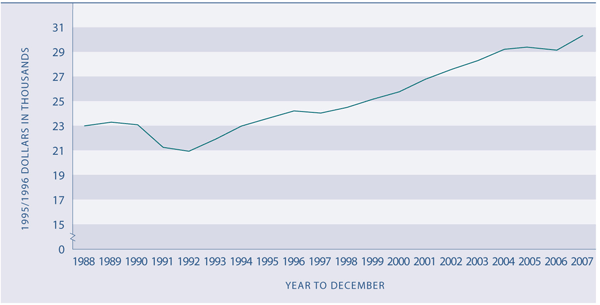Market income per person
Definition
The total value of goods and services available to New Zealanders, expressed in inflation-adjusted dollars, per head of population, also known as real gross national disposable income (RGNDI) per person.
Relevance
Per person RGNDI measures the average income available to New Zealanders. A nation with a rising per person RGNDI will have a greater capacity to deliver a better quality of life and standard of living to the population.
Current level and trends
In the year to December 2007, RGNDI per person was $30,255 in 1995/1996 dollars. This was 4 percent above RGNDI per person for the year ended December 2006 ($29,104). Between 1988 and 1990, RGNDI per person was just over $23,000. It then fell sharply to a low of $20,976 in 1992. From 1992, RGNDI per person grew continuously except for slight decreases in 1997 and 2006. The average annual growth rate over the whole period from 1988 to 2007 was 1.4 percent.
Figure EC1.1 Real gross national disposable income per capita, 1988–2007

Source: Statistics New Zealand
International comparison
While gross domestic product (GDP) per person is the measure most commonly used to compare income levels between countries, gross national income (GNI) per person more closely corresponds to the measure used in this indicator. To facilitate comparison, both measures are expressed in US dollars at current prices and current purchasing power parities (PPPs). By either measure, New Zealand was ranked 22nd out of 30 OECD countries in 2006, the same ranking as in the previous five years.59 Using GDP per person, New Zealand was the 18th most prosperous out of 26 countries in 1986 and the ninth most prosperous in 1970. Using GNI per person, the rankings for New Zealand were 19th in 1986 and eighth in 1970.
Between 1986 and 2006, real GDP per person (using US dollars and PPPs for the year 2000), grew by 30 percent in New Zealand compared with an OECD average of 46 percent.
Economic value of unpaid work
RGNDI does not take into account the value of unpaid work such as looking after one’s own children, cooking meals at home, fixing the car, doing home maintenance, or doing voluntary work in the community. Using data from the 1998/1999 Time Use Survey, the value of unpaid work in 1999 was estimated to be $39,637 million (1998/1999 dollars), equivalent to 39 percent of GDP, or $10,333 per person.60
|

